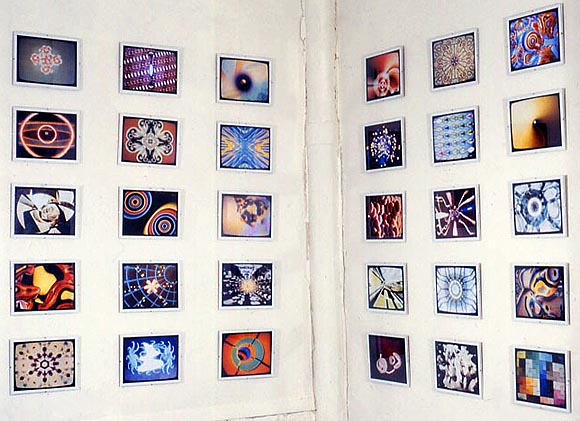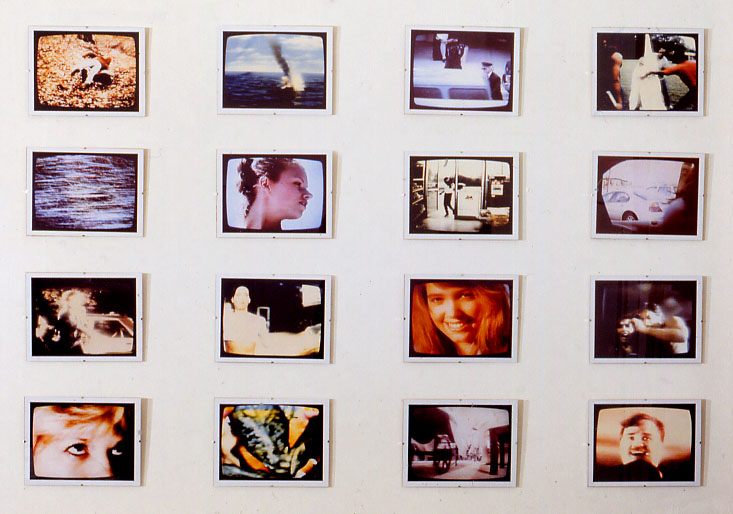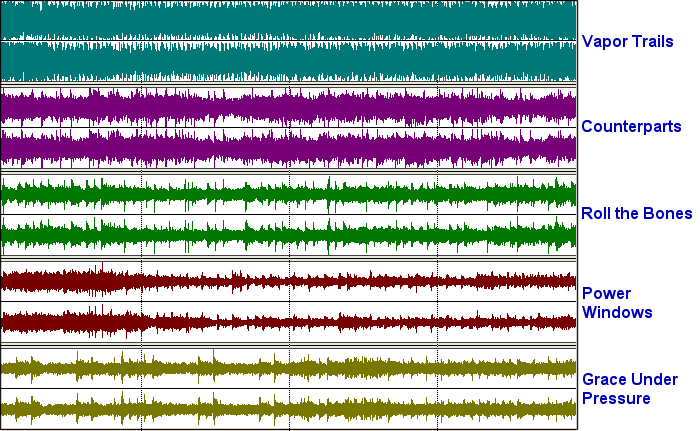View current page
...more recent posts

rave video stills - details / more details
Many of the "rave video still" photos above (discussed here, here, and here), which I made around 2000 with a 35 mm camera and a VCR pause button, came from "X-Mix" series of videotapes (see relevant disclaimers at the third link above). These were never shown, I was mostly just interested in them as "found abstraction"--there's some beautiful stuff on those tapes amid a lot of junk.
Cory Arcangel has made a YouTube sighting of one of the tapes. It is a computer animated version of an intense Plastikman track, from the "X-Mix 3" comp. As Cory says, "in the future when we try to describe the 1990s to people, we just need to show them this..."
Update, May 2008: Of course Arcangel's find has been removed from YouTube "at the request of Viacom."

The photos above (that's Set 1, Set 2 is here) elicited some discussion that explained them a bit, and I found out about some other people's tv documentation projects. Everyone's coming at this in a slightly different way--I like that there could be a micro-genre, like monochrome painting. Here is the relevant comment thread, hope you can follow it:
1. detail?
- paul (guest) 8-21-2006 1:12 pm2. You can click on the image and get a bigger view of the group. They're not particularly significant images individually. These are ink jet-prints from the original snapshots I made off the TV (videotapes). The idea was to freeze the frame on "transitional" shots that were never meant to be stills, with an emphasis on picking the most banal subject matter, then thinking about how they did or didn't relate in a grid.
There's really no good way to get this across on the web. And I've never had much response to them in person. But I remain stubbornly attached to the concept and my choices.
- tom moody 8-21-2006 2:28 pm3. cool. I think they're nice. just curious how the grain looks up close.
- paul (guest) 8-21-2006 3:39 pm4. They're pretty TV-grainy, but the prints have a nice quality--semi gloss finish photo paper.
- tom moody 8-21-2006 4:05 pm5. cool. along the same line, one still from each dvd i have rented so far in 06. i've been thinking of how to print it when i'm done. http://www.tinjail.com/tintype/?cat=18
- m.river 8-21-2006 6:53 pm6. we have this blog, we hope you like it..... tvontv.blogspot.com/
- Book House Boys (guest) 8-22-2006 8:10 am7. I suppose I should add that the first steps of my photos were analog. The TV was a CRT. The VCR was paused, I shot the photo with a 35 mm camera, and then took the film to a 24-hour lab. The resulting snapshots were then scanned and printed on nice paper with an Epson 2000P. The result is, I guess, "warmer"--although ideally the negatives would be printed the old way, with an enlarger, chemicals, etc., since the digital part of the process makes the work "colder."
- tom moody 8-22-2006 1:15 pm
Speaking of the Eyebeam Art and Technology Center reBlog, let's all watch Paddy Johnson put her feeds where her mouth is as she guest reBlogs for the next couple of weeks. No, that doesn't mean strapping on the feedbag. A while back she criticized the popular site for regurgitating too many frilly tech items, so they punished her by asking her to reBlog. Essentially what that means is she culls items from a pool of RSS blog "feeds" and posts them with as much text or as many pictures as she wants, in any order--an activity that as explained in the previous post combines blogging, curating, dj'ing and editing. It's different from "regular" blogging in that the material is all right there in the system, ready to be cut and pasted--no surfing around to find content is necessary. Paddy promises to put more art in the "art and technology"; naturally I hope she will consult my 10 Commandment-like "rules for reBlogging" as she invents her own set of guidelines. Here were a few, from '04:
1. reBlogging is definitely an art, somewhere between curating and editing. I believe the Eyebeam reBlog can be as important and genre-defining as any of the major umbrella tech sites, umbrella art sites (if those existed) or heaven forbid, regular news sources, as long as original material from a pool of steady dedicated bloggers is given equal weight to clips. The purely anecdotal has value, as does free lance reporting. Accordingly, I tried to emphasize unique, personal blog writing and research over news items recycled from big media sources. By and large I did not reBlog slashdot, boingboing or kottke, assuming that most people were looking at them anyway. I also avoided the major media feeds, such as NY Times, Yahoo, Wired, for the same reason.Go for it, Paddy!
2. I favored items with text or pictures over blind links with pithy 3-word captions.
3. I tried to keep a balance of tech and art writing.
4. I included a heftier dose of politics because the major media are failing us in that regard and we have to do what we can.
5. I added a few feeds where people are posting original art to the Web: Look, See; SCREENFULL; Wooster Collective.
Tech whiz Michael Frumin is leaving Eyebeam Art and Technology Center for his next gig somewhere in the Matrix, and I want to offer kudos for the work he did over there on 21st Street. His reBlog software, which allows guest bloggers to recycle RSS feeds in a way that combines curating, editing and dj'ing, is Da Bomb: much adopted and imitated. Excellent work, Mike, may you be just as influential in the next job and the next and the next.
Via Wikipedia: "A discussion on how overuse of compression on modern compact discs is ruining the sound and dynamic range with particular reference to Vapor Trails by Rush," by Rip Rowan. Excerpt:
"Here is a side-by-side picture showing a sample of audio from five different Rush CDs. On the top is the latest CD, Vapor Trails (2002). Below that, going back a few years, is a sample from the Counterparts CD (1993). Going back a year is a sample from the Roll The Bones CD (1992). Next is 1985ís Power Windows, the first Rush CD to be recorded entirely digitally. On the bottom is a sample from the Grace Under Pressure CD (1984) which immediately preceded Power Windows and was recorded to analog.

An earlier excerpt:
"Over the past few years, record labels have increasingly attempted to dictate to the artist and producer the target volume level of the CD. For some reason, record labels have it in their head that 'LOUD' equals good, and therefore, 'LOUDER' equals better. Not caring to understand even the basics of audio, these morons simply demand more volume (typically from the mastering engineer) and really donít understand--or care--about the consequences of their demands.
"Mastering engineers are caught in a Catch-22. If they do not deliver a product that is appropriately LOUD, then they are considered inept by the labels and are shunned. If they refuse to destroy the artistís music, then they arenít being 'team players' and quickly fall out of favor. But if they provide what the customer demands (and remember, the label, not the band, is the customer) then they ruin a perfectly good piece of music, and they know that sooner or later, people are going to figure out why the sound is so horrible, and then the mastering engineer will be blacklisted for having followed orders.
"Having said all that I really donít know what I would do in their shoes. If someone offered YOU the opportunity to master a Rush CD, and then told you that you would have to destroy the sound quality in order to get the job, how would you respond? It isnít a clear or easy choice."
[G.K. Wicker brought up this issue on this blog awhile back. The comparison chart really hits it home. Another reason to hate the record companies--besides limiting creative freedom, they are conspiring to destroy our hearing. --tm]
"More Marching Morons" [mp3 removed]
"Back-Catalog"
My animation log (updated in clumps).
My (mostly) music blog (as in, my tunes--up to about 170 now, including collaborations and alternate versions).

